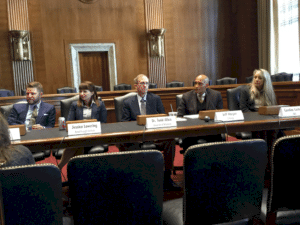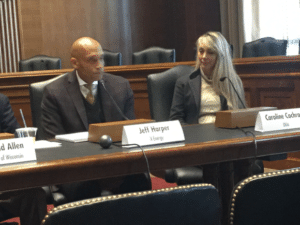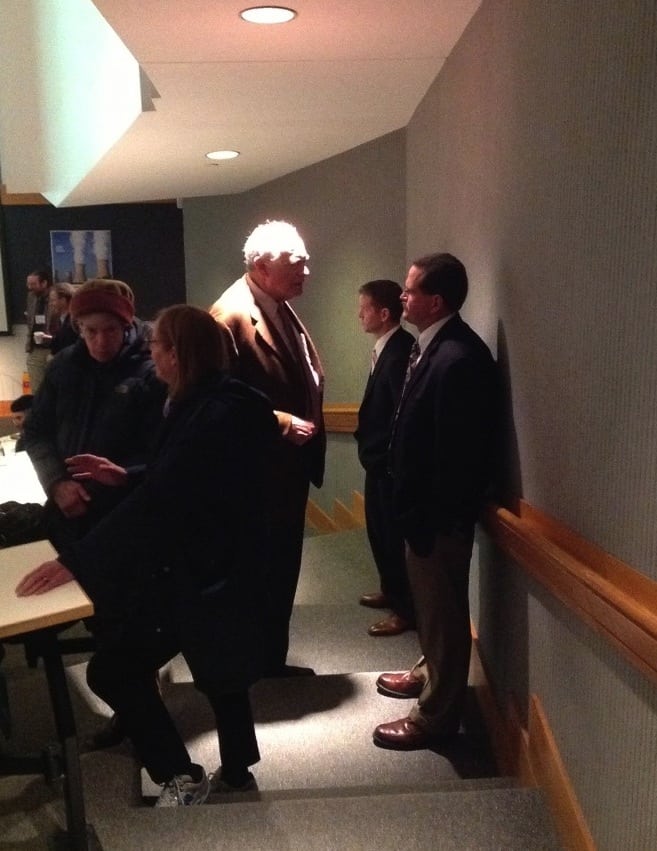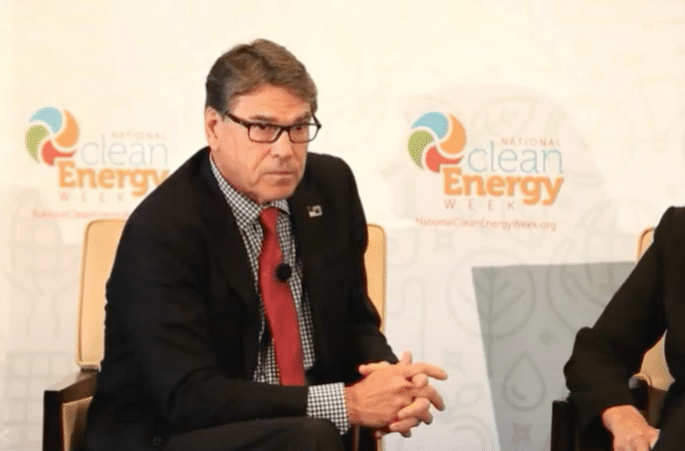Nimble creators plan to avoid some of the struggles plaguing extra-large nuclear projects

Left to Right: Josh Freed, Jessica Lovering, Todd Allen, Jeff Harper, Caroline Cochran
Paying attention to Sen Murkowski
In late March, Senator Lisa Murkowski and her staff played host to some of the leading thinkers in the growing community of people who believe that nuclear energy is too important to fail without trying to do things both differently and better.
The occasion of the meeting was the introduction and release of a new study published by The Breakthrough Institute titled How to Make Nuclear Innovative: Lessons From Other Advanced Industries. The report “makes the case for an entirely new model of nuclear innovation. Instead of conventional light-water reactors financed and constructed by large incumbent firms, the advanced nuclear industry will be characterized by innovative reactor and plant designs, new business models, and smaller entrepreneurial start-ups.”
The event included a panel discussion about some of the recommendations in the report. That panel was moderated by Josh Freed from Third Way and included Jessica Lovering, the lead author of the report; Todd Allen, currently a nuclear engineering professor at the University of Wisconsin and formerly of both Third Way and the Argonne National Laboratory; Jeff Harper, Vice President of X-Energy; and Caroline Cochran, co-founder of Oklo.
Both X-Energy and Oklo are small, entrepreneurial start-up companies that are developing reactor power systems that are as different from the conventional models as Teslas are to Greyhound Buses.
Why Is An Entirely New Model Needed?
Outside of Asia and Russia, prospects for nuclear power plants in the extra-large size range seem to be dimming by the week. It has been several decades since the last project made it through the full distance marathon required to design, site, license, construct and complete a new nuclear power plant.
The Watts Bar units that are the most recently completed plants in the U.S. were designed, sited and licensed while I was still in grade school – and I am a semi-retired grandfather of six.
The two primary designs on which the established nuclear industry in the U.S. banked (AP1000 and ESBWR) and the single design that received most of the investments from France and Germany (EPR) are still years away from the first units being in operation, even though the design work began before or just after the turn of the century.
It can be quite discouraging to be a nuclear energy advocate.
Fortunately, the lesson that many who study the energy industry and understand atomic fission’s vast technical potential is that the old guard just hasn’t done it right. These creative go-getters aren’t pushed off into a different industry by the current struggles at Vogtle, Summer, Olkiluoto, and Flamanville. They see those projects as indicators that there has to be a better way and they are doing their utmost to devise that better way before it’s too late.
Why Not Just Give Up On Nuclear?
It may sound a little odd in a world where there are frequent messages about the inevitability of a 100% renewable energy system, or about the vast new supplies of hydrocarbons married to promoted doubts about the potential risks of climate change, but the atomic innovators honestly believe that they are working to save the world.
There are probably a few exceptions, but most of them seem sincerely convinced that human society will be much better off with accessible, proven and affordable nuclear energy options than without them. At this stage in the development of alternatives to the conventional nuclear systems, it’s not surprising to find that the leaders are motivated by more than money.
Most of them must know that there are many more paths to losing a great deal of money than there are paths to a lucrative outcome, but they are each confident that they are members of a team that is on one of the paths that leads to success.
So What Does The New Study Recommend?
The report provides the following recommendations.
- LICENSING REFORM. Licensing of new nuclear technologies will need to be reformed in order to support smaller, entrepreneurial firms and to build investor confidence as key design and testing benchmarks are achieved.
- PUBLIC-PRIVATE PARTNERSHIPS. National laboratories will need to provide private companies with access to equipment, technical resources, and expertise in order to lower costs and promote greater knowledge spillover in the testing and licensing process.
- TARGETED PUBLIC FUNDING FOR R&D. Significant and sustained research funding should be directed toward solving shared technical challenges.
- INTER-FIRM COLLABORATION. Policy and funding should be designed to encourage knowledge spillover and collaboration between companies.
- PRIVATE-SECTOR LEADERSHIP. Public investment in demonstration and commercialization should follow private investment and avoid early down-selection of technologies.
It bases those recommendations on an evaluation of the successes and challenges faced by four other industries that share some commonality with nuclear power systems. The authors looked at wide-body aircraft, pharmaceuticals, hydraulic fracturing/horizontal drilling and privately designed space systems.
Three of those industries have a strong, independent, federal regulator. The fourth is an innovative energy technology that is regulated mostly on a state by state basis. All have enormous capital investment requirements, require patient investors, and benefit from various types of government support and encouragement.
The report identifies a number of reasons to be optimistic that the American nuclear industry can once again become an example for the world, possibly one that is closer to the vision that President Eisenhower had in mind when he composed his December, 1953 speech to the United Nations. Here is a description of some of the advantages the U.S. needs to harness.
The highly competitive, liberalized electricity market is already encouraging a number of nuclear start-ups to attempt to disrupt the market with more radical designs. And America’s world-class nuclear engineering programs and network of national labs are valuable assets for burgeoning innovators, as is its well-developed venture capital and entrepreneurial sector. Changing trends in national innovation systems suggest that a networked, bottom-up, privately led nuclear innovation effort might succeed where the old top-down innovation model has failed.
That should not be read as a call to dismantle the public institutions that have played a critical role in the development of nuclear energy as a clean and cheap source of electricity that still accounts for almost 20% of US generation. But to assure a future for nuclear energy in the United States and beyond, those institutions, including the Nuclear Regulatory Commission, the Department of Energy, and the National Laboratories, will need to change, expanding their missions to support private-sector innovation and facilitate commercialization of innovative nuclear designs.
What’s Missing From The Report?
One item that is missing from the report that could make a huge difference in whether or not the recommendations can be implemented and succeed is action to require that safety regulations be based on science instead of mythology. All current discussions of risk associated with nuclear energy is fundamentally based on the notion that there is “no safe dose” of radiation and that every exposure, down to a single low-energy gamma ray, carries a greater than zero probability of causing harm to human health.
That notion is false. It was imposed on the public with a carefully planned promotion campaign that culminated with a June 13, 1956 New York Times front page headline claiming that radiation was a peril to mankind. The headline was justified by a report from a committee representing the most credible scientific organization in the U.S., but that committee was stacked with people who owed loyalty to a foundation funded by the biggest of Big Oil. The chairman of that committee was the foundation employee who approved their research grants.
They were well-motivated to scare people about radiation and to overemphasize its hazards.
In the sixty years since that announcement was made, regulations have been ratcheted down to lower and lower levels while science has been discovering more and more evidence pointing to the fact that doses below certain levels are not only harmless, but healthy.
Upending the “no safe dose” basis for regulations will not be easy because there are many who benefit from the burdens that the assumption places on nuclear system development, deployment and operation. However, it is the right thing to do from a scientific and societal point of view.
Is There Hope For Action And Progress?
It’s worth noting that there is a bipartisan, multicameral effort underway to draft and pass legislation that will take steps towards implementing some of the recommendations made in this and other reports about ways to enable nuclear energy development. Both the House and Senate have bills that are making their way through responsible committees.
Republicans and Democrats, conservatives and liberals have reasons to support nuclear energy development as a way to improve the economy, improve the environment, enable poverty reduction, reduce foreign entanglements and improve global stability. The Breakthrough Institute’s most recent report does not have all the answers, but it is a report worth reading.
Note: A version of the above was first published on Forbes.com. It is republished here with permission.





Been wading through
Burden of proof: A comprehensive review of the feasibility of 100% renewable-electricity systems (B.P. Heard, B.W. Brook, T.M.L. Wigley, C.J.A. Bradshaw in Renewable and Sustainable Energy Reviews
Volume 76, September 2017, Pages 1122–1133. Its a bit of a slog.
The review identified 24 “potentially feasible” 95+% solutions worth considering. But none were found to meet the authors’ fairly realistic final feasibility criteria for reliable electricity systems needed to meet electricity demand this century. Or even come close.
There’s a lot riding on the nuclear industry, both new and old.
Try that link again:
Burden of proof: A comprehensive review of the feasibility of 100% renewable-electricity systems by B.P. Heard, B.W. Brook, T.M.L. Wigley, C.J.A. Bradshaw in Renewable and Sustainable Energy Reviews Volume 76, September 2017, Pages 1122–1133.
Ed,
The authors of “Burden of proof….” chose their criteria such that no present simulation will meet their criteria. So they could reject all 100% renewable scenarios.
E.g. Criterium 2:
“simulating supply to meet demand reliably at hourly, half-hourly, and five-minute timescales, with resilience to extreme climate events”
No realistic 5 minutes timescales are possible (or necessary) even not in more advanced NW-Europe as power is still traded in chunks of 15minutes (USA 60minutes).
But if someone would do a simulation on 5minutes timescale they still have the “resilience to extreme climate events” argument to discard the results.
Forgetting that:
– electricity supply is ~10 times more reliable in countries with a lot generated by wind & solar, such as Germany (20%) and Denmark (40%);
– nuclear power delivers baseload, which implies that it’s not suitable for more than 75% (even not in combination with hydro as France demonstrates).
While no expert doubts that renewable can deliver >95% against a lower price.
Also demonstrated by the fact that quite a number of advanced countries target >95% share of renewable while no country targets >55% for nuclear.
Come on Bas, there are weaknesses in the paper, but you didn’t manage to find them. You can do better than that!
Now, to make sure that your misinformation doesn’t hang around without a response I have addressed each point that you raise:
5 minute simulations are absolutely possible, and are essential if you would have problems from a short power outage, as are simulations that include extreme climate events.
Electricity supply reliability is a complex thing to measure, and at the end of the day most statistics for measuring it are dominated by long duration, small area outages in the network rather than at the power generation or whole grid level. Germany and Denmark do very well at this, other countries not so much. The things that make the networks good are expensive, so when you look at lists of network reliability by country you see that they there is reasonable correlation with GDP (and to a lesser extent land area) rather than the generation method. Of course, if there isn’t enough electricity to go around there will be blackouts no matter how good the network is.
Nuclear is great at base load, but it is very capable of adjusting rapidly to demand as well. Nuclear submarines wouldn’t be much use if they couldn’t rapidly change speed, would they? The reasons that most current nuclear power plants run to maximize base load production are mostly economic and regulatory, not technical.
Many experts claim that renewables are expensive, so I have no idea what you are claiming here. Same with national targets, these are set by politicians and have nothing to do with technical merits.
One of the most annoying things about anti nuclear activists is the way that you get forced into attacking other power sources in order to defend nuclear power. While in the long term (thousands of years) nuclear power is the only source with an adequate energy density for continued growth, for the foreseeable future a diverse energy mix is the best way to go, and yes, this should include wind and solar where appropriate.
“…experts claim that renewables are expensive…”
That’s the past. And wind, solar and storage continue their price decrease paths.
Consider e.g. the 350MW PV-solar tender of Abu Dhabi. Won by a consortium which installs, operates and decommission the farm for a guaranteed price of 2.3cnt/KWh for all produced electricity during 20years. GTM research predicts that prices for next tenders (SA, UAE, etc) will decrease towards below 2cnt/KWh this year! I estimate next year.
Btw.
Don’t compare with US & EU market prices as those are artificial high due to the import taxes (EU; 45%) on Chinese PV-panels.
@Bas
The densely populated areas of the U.S. and EU have little or nothing in common with Abu Dhabi. We have a lot more clouds, rain and short winter days. We pay people who install solar farms more than slave wages, we expect all enterprises to pay their fair share of taxes and our real estate is worth a lot more than empty desert.
All of those factor into the very low prices promised for solar PV electricity, which even in Abu Dhabi isn’t the same product as the stable frequency, 24 x 7 power that is produced in a nuclear power plant.
Its a bit like comparing a BWM to a bicycle and claiming that the bicycle provides cheaper transportation.
Rod,
We agree that:
– such low prices won’t be reached soon in dense populated areas with far less sun and an high paid labor force, such as NL, etc.
– PV-solar, though highly predictable, doesn’t produce 24/7.
But it’s smart to realize that continued price decrease for PV-solar during next decades is widely predicted. So gradually even US, starting in the sunny regions, will see significant lower prices than the ~4cnts/KWh Austin and the ~6cnts/KWh Georgia Power bought PV-solar.
@Bas
The problem I have with predictions of ever lower costs for solar is that few, if any, of the panel makers are profitable at current prices. The market is oversupplied, making it a buyers’ market. When governments finally realize that they jobs they are supporting with continued subsidies are not terribly productive jobs for the rest of the economy, the subsidies and low interest loans to the factories will slow and finally stop.
There is a market for panels, but it is not as large as current production capacity. Higher cost producers will drop out, and the more efficient producers will finally be able to regain enough pricing power to move panel prices into the range where they are selling for more than they cost to manufacture – including all associated overhead costs.
I predict that eventually, there will be a somewhat profitable business of producing solar panels for customers where the systems make sense. That market will probably not be large enough to even make a visible difference in overall energy use statistics.
At some point, even the emperor will realize that his clothes are quite thin and not concealing very much.
Rod,
The PV-panel world market increased from 30GW in 2012 to 73GW in 2016. That is an annual grow of 25%.
So most over-capacity will be absorbed by that.
Don’t know the P&L figures of most producers, but those of Sunpower (which I intent to install on my roof) look fine.
And big new parties, such as Huawei, are entering the market. Which will contribute to further price decreases.
Apart from that, production lines for PV-cell and -panel production can and will be much more automated. Compare the complexity and price of flat-screen TV’s with the simplicity and price of PV-panels. So I estimate that prices of $100mln/GWe will be reached in big projects.
Even here in NL with our high latitude, the first houses & buildings with so much solar in/on their roofs combined with good isolation and heat pumps, that they become energy independent.
Considering also the decreasing prices for Power-to-Gas and batteries, what’s the future for classic power plants?
The question explains the move away from classic power plants by the major German utilities (E.on, RWE). Those try to reform towards service companies, organizing Virtual Power Plants, etc.
Where did you get the figures for greater reliability where much of the electricity is from wind & solar?
https://www.electricitymap.org/
shows how much CO2 is being created for electricity generation in various European countries. The countries that are consistently low CO2 generators use a lot of nuclear, hydroelectric or both. The countries trying to use a lot of wind & solar generate a lot of CO2.
Here statistics with discussion about a.o. (wrong) ideas that switching off classic power plants would harm reliability.
US SAIDI (~2hrs) gives a rosy picture compared to EU, because US excludes outages due to extreme weather. Hence my 10times worse (also based on an IEEE report).
Sorry, the missing link: https://www.cleanenergywire.org/factsheets/germanys-electricity-grid-stable-amid-energy-transition
“While no expert doubts that renewable can deliver >95% against a lower price.” This is a truly bizarre comment, and the converse is the case. Why have so many eminent scientists signed this letter. I actually think the converse is true, that if we surveyed international scientists with an h-index > 30 or any other number, we would find a 97% consensus that 100% isn’t going to work.
Graeme the letter states: “… climate scientists have recently advocated the development of safe, next-generation nuclear energy systems…”
Time needed to develop “safe, next-generation nuclear” is unclear. But that won’t be available before 2030 (if at all). Then, planning & construction takes another 10years.
So let’s develop renewable in the meantime as climate change doesn’t wait.
Btw.
– The letter argues against wind and solar only. I agree.
Renewable is far more. Countries are migrating towards >95% renewable.
– We agree that 100% is still under discussion. But adding nuclear doesn’t improve the migration considering its costs, long lead times, and its incompatibility with high shares of wind & solar.
Safe next generation nuclear plants are being built today. There is no need to delay until 2030 to begin building them. Improved products will certainly be available; they can be implemented as they achieve readiness to deploy. For example, I predict that there will be dozens of NuScale modules in revenue generating service before 2030.
Countries like NL are free to try to move towards a mostly renewable energy supply system. I see no evidence in my country of any desire among the population to make the sacrifices such a plan would require.